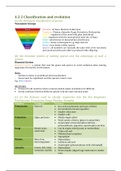4.2.2 Classification and evolution
(a) the biological classification of species
Taxonomic Groups
Domains: Archaea, Bacteria, Eukaryotae
Kingdoms: Plantae, Animalia, Fungi, Protoctista, Prokaryotae
Phylum: organisms of the same body plan (vertebrae)
Class: organisms with the same general traits (no. of legs)
Order: sub-division of characteristics (herbivora)
Family: closely related genera e.g. dogs and cats
Genus: very closely relates species
Species: all members are basically the same with a few variations
and can breed with each other to produce fertile offspring
(b) the binomial system of naming species and the advantage of such a
system
Binomial System
Binomial system: a system that uses the genus and species to avoid confusion when naming
organisms. Devised by Carl Linnaeus.
Rules:
- Written in italics or underlined when handwritten
- Genus must be capitalised, and the species is lower-case
E.g. Homo sapiens
Advantages:
• Universal to all countries where common animal names are likely to be different
• Avoids confusion between different species with the same common name
(c) (i) the features used to classify organisms into the five kingdoms:
Prokaryotae, Protoctista, Fungi, Plantae, Animalia
Kingdom Examples Features
Prokaryotae Bacteria • No nucleus (plasmids and loops of DNA)
• No membrane-bound organelles
• Smaller ribosomes
• Smaller cells
Protoctista Algae, protozoa • Mostly single-celled
• Wide variety of forms (plant or animal like)
• Autotrophic or heterotrophic nutrition –
photosynthesis, ingestion, saprotrophic nutrition
Fungi Mould, yeast, • Can be single celled (yeast) or multicellular
mushroom • Chitin cell wall
• Multinucleate cytoplasm
• Saprophytic
Plantae Moss, fern, • Multicellular
flowering plants • Cellulose cell wall
• Autotrophic (photosynthesis with chlorophyll)
Animalia Insects, fish, birds, • Multicellular
mammals, reptiles • Heterotrophic (digest large molecules to smaller
ones





